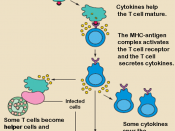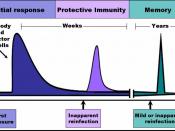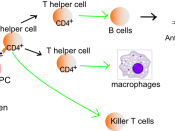How does structure facilitate function?
The layered, expansive structure of the immune system facilitates its function to protect the body. The immune system is a group of cells, molecules, and organs that act together to defend the body against foreign invaders that may cause disease, such as bacteria, viruses, and fungi (Starr 582). The health of the body is dependent on the immune system's ability to recognize and then repel or destroy these invaders. The layers of immunity defense include innate immunity, adaptive immunity, humoral immunity, and cell-mediated immunity (Immune System March 2001). Our bodies require all of these immunity defenses just to keep us healthy daily. If we were missing the immune system in any part of our body, we would most likely not live very long.
There are several different parts which make up the whole immune system. White blood cells make up a large part of the immune system.
Some white blood cells, known as macrophages, play an important role in adaptive immunity in that they attach to invading antigens and deliver them to be destroyed by other components of the adaptive immune system. Lymphocytes are specialized white blood cells whose function is to identify and destroy invading antigens. Some lymphocytes mature in the bone marrow and are called B lymphocytes or B cells. B cells make antibodies, which circulate through the blood and other body fluids, binding to antigens and helping to destroy them in humoral immune responses. Another type of lymphocyte, called T lymphocytes or T cells, mature in the thymus, a small gland located behind the breastbone. Some T cells, called killer T cells, generate cell-mediated immune responses, directly destroying cells that have specific antigens on their surface that are recognized by the killer T cells. Helper T cells, a second kind of...


